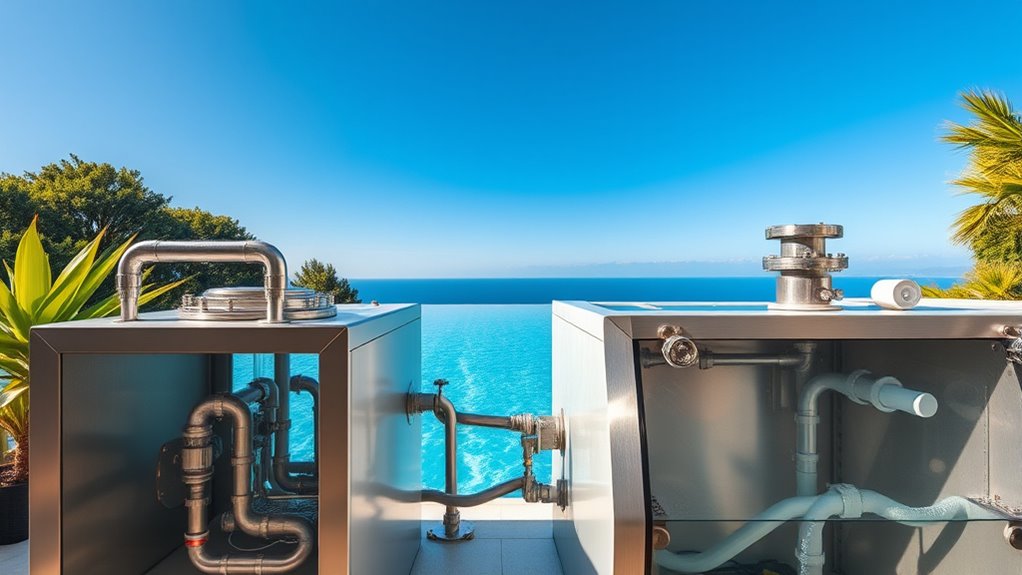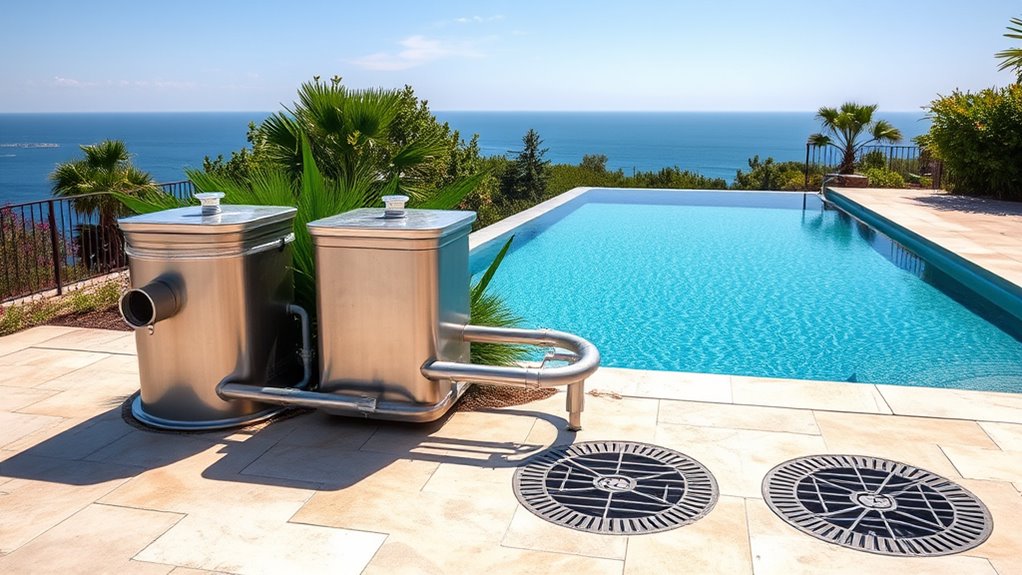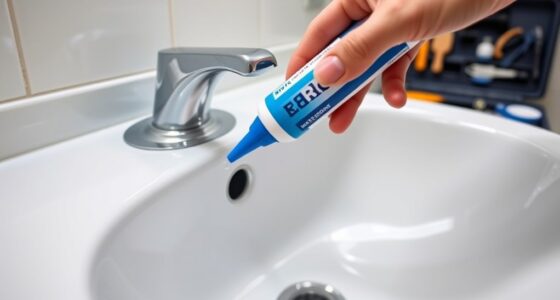Surge tanks and catch basins are vital for your infinity pool’s plumbing system, helping to manage pressure surges and prevent debris blockages. Surge tanks absorb rapid pressure changes, protecting pipes and equipment, while catch basins collect leaves and dirt before reaching pumps. When installed properly and maintained regularly, they keep your pool running smoothly and extend system lifespan. Continue exploring to learn how to optimize these components for your pool’s safety and durability.
Key Takeaways
- Surge tanks absorb pressure spikes, ensuring smooth water flow and preventing damage to the pool’s plumbing system.
- Catch basins trap debris and prevent clogging, protecting pumps and filters from debris-related issues.
- Together, surge tanks and catch basins enhance system safety by managing pressure and debris, extending infrastructure lifespan.
- Proper installation involves strategic placement in turbulent areas and correct sizing for efficient operation.
- Regular maintenance of both components is essential to sustain water quality, prevent leaks, and ensure long-term durability.
Understanding the Role of Surge Tanks in Infinity Pool Systems

Surge tanks play a crucial role in maintaining the stability of infinity pool systems by managing sudden changes in water pressure and flow. When the pool’s water level fluctuates or pumps turn on and off unexpectedly, pressure can spike, risking damage to the system. Surge tanks absorb these shocks, preventing pressure surges that could compromise your pool’s structural integrity. By acting as a buffer, they ensure the water pressure remains steady, protecting pipes, fittings, and the pool structure itself. Without a surge tank, these pressure fluctuations could lead to leaks, cracks, or even system failure. Properly designed and installed, surge tanks help maintain the durability of your infinity pool, allowing it to operate smoothly and safely over time.
The Function and Placement of Catch Basins in Pool Plumbing

Have you ever wondered how pool plumbing prevents debris and sediments from clogging your system? Catch basins play a crucial role in water filtration by capturing leaves, dirt, and other debris before they reach the pump and filter. Proper placement ensures they’re positioned where debris tends to accumulate, typically near inlets or low points in the plumbing system. Beyond filtering water, catch basins provide structural support for the plumbing network, helping to distribute pressure evenly and prevent pipe damage. They also act as access points for cleaning and maintenance, keeping your pool’s circulation smooth. Correct placement and design of catch basins maximize efficiency, protect your equipment, and ensure clean, clear water in your infinity pool. Additionally, understanding the importance of proper installation can significantly improve the longevity and performance of your pool’s plumbing system.
How Surge Tanks and Catch Basins Work Together to Prevent Damage

When water flow in your pool system changes suddenly, it can cause pressure surges that threaten to damage pipes and equipment. Surge tanks and catch basins work together to absorb these sudden shifts, protecting your system. The catch basin collects excess water, preventing backflow and flooding, while the surge tank accommodates rapid pressure changes. This synergy ensures steady water flow, safeguarding components like pool lighting and water filtration systems. Without these devices, pressure spikes could cause leaks, cracks, or damage to sensitive parts. By managing water levels and pressure fluctuations, surge tanks and catch basins extend the lifespan of your pool infrastructure, keep your system running smoothly, and help maintain a safe, efficient swimming environment. Proper dynamic communication exercises can also help identify early signs of system stress or malfunction, ensuring timely maintenance.
Key Factors to Consider When Installing These Components

Installing surge tanks and catch basins requires careful planning to guarantee they function effectively and safely. During pool construction, consider their placement to optimize water circulation and prevent pressure buildup. Position these components where water flow is most turbulent to maximize their efficiency. Ensure the inlet and outlet connections are correctly sized for your pool’s flow rate, avoiding restrictions that could hinder circulation. Proper sealing and secure mounting are essential to prevent leaks and structural issues. Think about accessibility for future inspections or repairs. Additionally, confirm the surrounding area can support the weight and provide adequate drainage. Taking these factors into account helps maintain balanced water movement, reduces stress on your plumbing system, and prolongs the lifespan of your surge tanks and catch basins. Consulting total‑cost clarity and maintenance schedules can further ensure your system remains efficient over time.
Maintenance Tips for Ensuring Long-Term Performance

Regular inspection and cleaning are essential to keep surge tanks and catch basins functioning properly over time. Regularly check for debris buildup and clear out any obstructions to maintain water flow. Keep an eye on your pool chemical levels, as improper chemical balance can cause corrosion or algae growth that impacts performance. Verify your water filtration system is working efficiently by cleaning or replacing filters as needed. This prevents contaminants from clogging the catch basin or surge tank, which could lead to overflow or damage. Also, inspect for leaks or cracks, addressing issues promptly. Consistent maintenance helps extend the lifespan of your components, keeps water quality high, and ensures your infinity pool remains a seamless, beautiful feature.
Frequently Asked Questions
Can Surge Tanks Be Customized for Different Pool Sizes?
Yes, surge tanks can be customized for different pool sizes. You’ll want to take into account surge tank capacity to match your specific pool volume and circulation needs. Additionally, catch basin design plays an essential role in ensuring proper water flow and pressure management. Customizing these components allows you to optimize your infinity pool’s plumbing system, preventing overflow or pressure issues and ensuring smooth operation tailored to your pool’s size and usage demands.
What Materials Are Best for Catch Basins?
You should choose durable materials like concrete, fiberglass, or high-density polyethylene for catch basins, as they offer excellent durability and resistance to chemicals and weather. When selecting materials, consider durability considerations to guarantee long-lasting performance under constant exposure to pool water, debris, and environmental elements. Fiberglass and high-density polyethylene are lightweight and easy to install, while concrete provides strength and stability for larger setups.
How Do Weather Conditions Affect These Components?
Weather conditions markedly impact catch basins and surge tanks through climate impact and seasonal variations. Cold temperatures can cause materials to crack or become brittle, while heavy rain may overwhelm drainage capacity, leading to backups or flooding. In hot, dry weather, debris buildup increases, clogging components. You should regularly inspect and maintain these parts, considering seasonal changes to guarantee proper function and longevity in varying climate conditions.
Are Surge Tanks Suitable for Saltwater Infinity Pools?
A stitch in time saves nine, and your saltwater infinity pool benefits from surge tanks. Yes, they’re suitable if you choose corrosion-resistant materials, like specialized stainless steel or plastics. While they reduce maintenance requirements by controlling water pressure fluctuations, you still need to check for salt corrosion regularly. Properly selected surge tanks guarantee longevity and peak performance, making your investment well worth it.
What Signs Indicate a Need for System Upgrades?
You should consider upgrading your system if you notice frequent maintenance needs or if the system capacity feels insufficient. Signs such as persistent leaks, slow water flow, or unusual noises indicate that your plumbing may be overwhelmed or aging. Upgrading guarantees your infinity pool’s surge tanks and catch basins operate efficiently, reducing maintenance frequency and preventing costly repairs. Regularly assess these signs to keep your pool functioning smoothly and extend its lifespan.
Conclusion
Understanding surge tanks and catch basins is vital for maintaining your infinity pool’s performance and longevity. Did you know that proper plumbing design can reduce water pressure issues by up to 30%? By ensuring these components are correctly installed and maintained, you’ll enjoy a seamless, stress-free swimming experience. Keep these systems in top shape, and you’ll prevent costly repairs down the line—making your luxurious pool truly worth every drop of effort.









